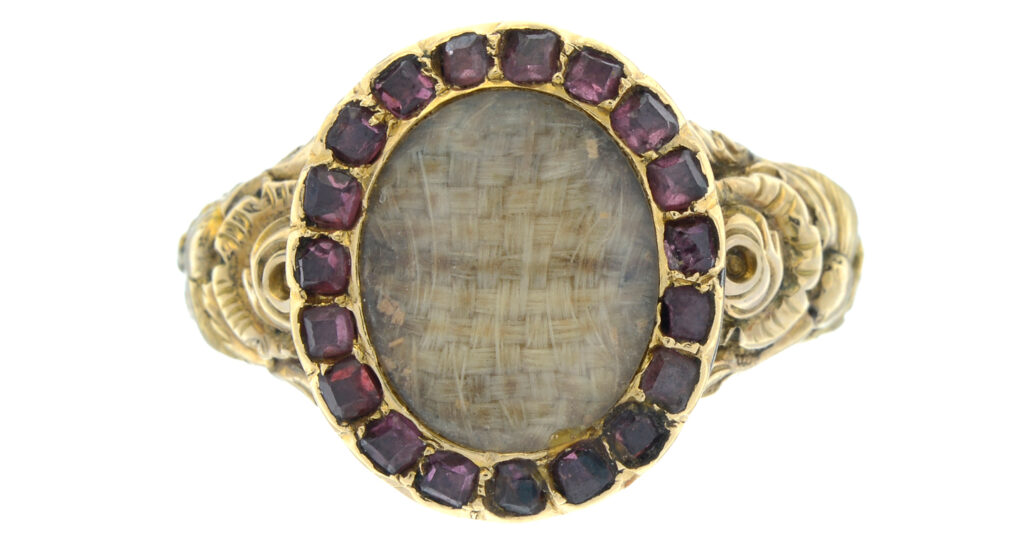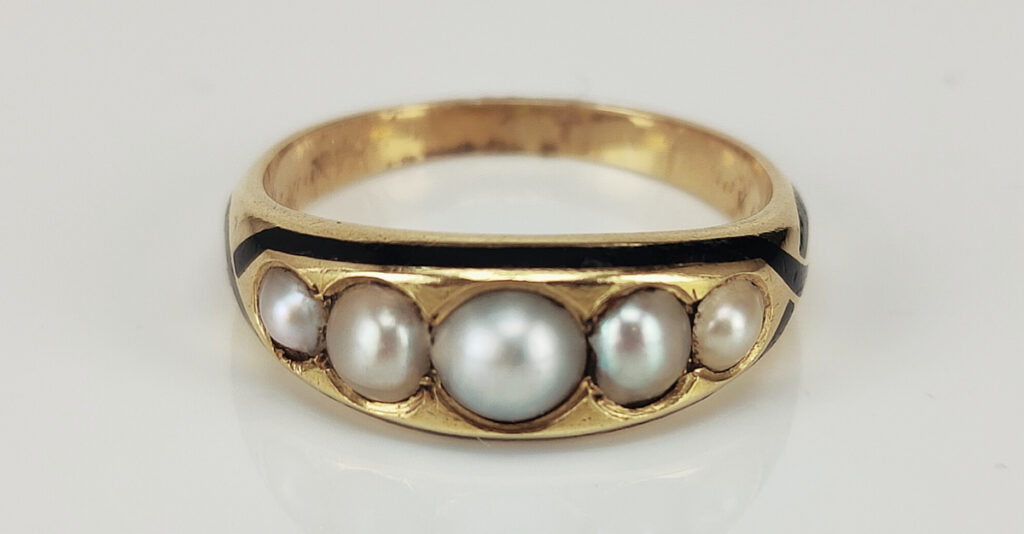Neoclassicism & Love in a Sentimental Ring
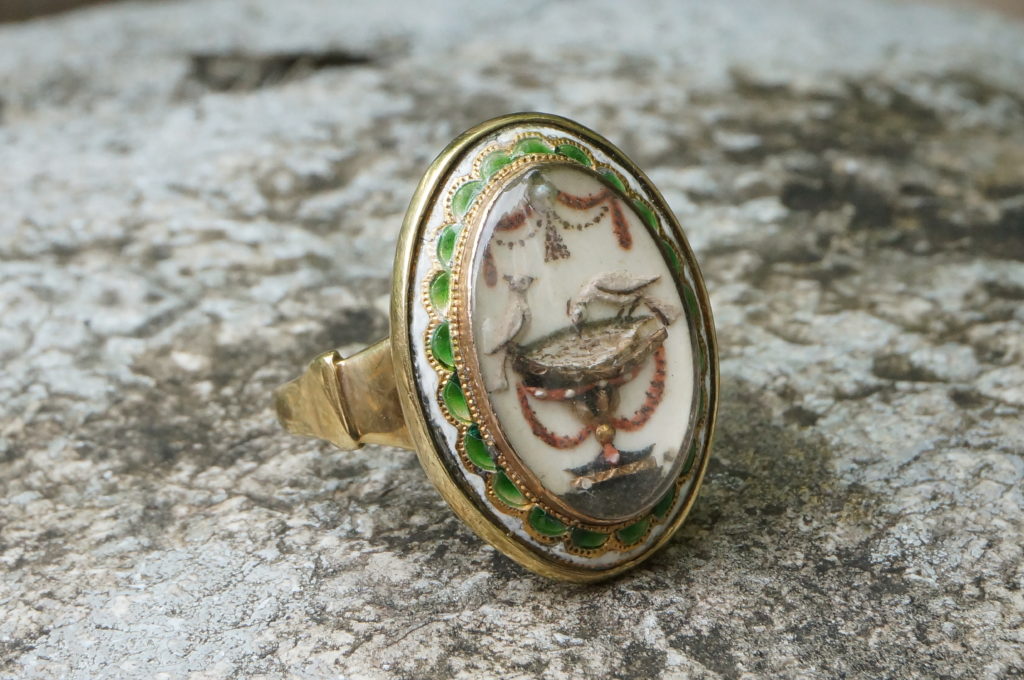
A relationship is a series of shared moments that are consigned to memory. Holding the value of a memory with another is one of the most personal and intimate elements that can help resonate love through time. In jewellery, the memory of being worn and being referenced by the wearer to trigger the memory is essential for the sentimentality of the jewel. Some jewels are anonymous, a band with a gem, to denote anything from a marriage to a moment. Others have been designed to be more overt and state their meaning in a very obvious way. No period harnessed these values so greatly as the Neoclassical period of c.1760-c.1820. During this time, digs in Pompeii and Herculaneum had discoveries in 1711, but resumed with major excavations in 1738, igniting the passion and interest in artists, thinkers and antiquarians. What stemmed from this was a change in how relationships were represented in jewellery. A major humanist movement in the Enlightenment was represented in Neoclassical jewels, which represented allegorical scenarios in concepts of life and society.

In this jewel, both an honouring of history and the capturing of a moment are both present. The basis for this image comes from a Roman floor mosaic discovered in 1737 at Hadrian’s Villa in Tivoli. Named ‘Sous of Pergamon’, the scholar Pliny the Elder described Alexander the Great’s original version of this in Natural History, which was completed in 77AD. Hadrian’s mosaic from his villa is now in the Capitoline Museum, which lends the depiction the name of the ’Capitoline Doves’, or in reference to Pliny’s description of the original, the ‘Pliny Doves’.

Historical fascination of the Neoclassical period gave way to an overwhelming number of jewels being created to emulate classical styles. In the fashion of the Greco-Roman mosaics, micromosaic jewels were created to represent the Capitoline Doves in high volume from the c.1770s onwards. With a strong basis of the doves drinking at the bowl, its interpretation into other sentimental jewels was understood enough to proliferate its meaning.

Usage of the dove, representing the Christian Holy Ghost/Spirit, is a common symbol found in jewels of the 18th and 19th century. Greek depictions show the dove with the goddess of love, Aphrodite, or Venus in Roman mythology, representing that no higher love could be attained. The symbolism is attributed to peace and the concept that there is peace in the afterlife from conflict in life. Seen in this ring, the birds are at peace and represent love in its union of the two, without any interference by others. It is an idyllic scene, which is dressed in Neoclassical pomp.
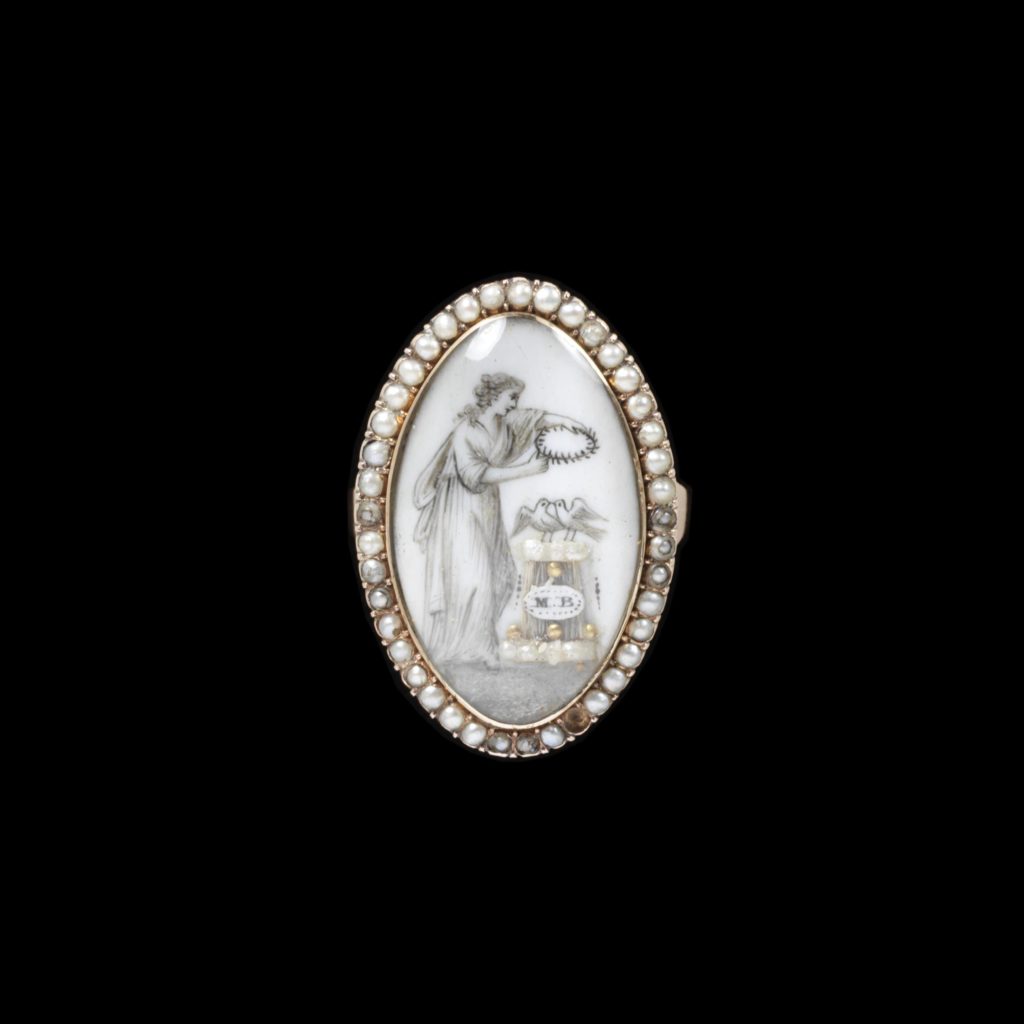
The basic elements of memorial and sentimental Neoclassical jewels are the mourning figure, who are predominantly female, the urn, column/plinth, willow and cypress. Late 18th century opulence was driven by the amount of excess that the scenario could be filled with. Garlands, flowers, drapery and excessive detail in small designs were the levels of quality that could show the love for another in a jewel. So far, this jewel has depicted the love between two people, its serene and giving display of the birds sharing a moment within the jewel is not obscured by any other living element. In the ring above, the lady adorns the loving birds with the wreath, in a form of honouring the love, as one would a crown. Its detail matches the ring of this article, as the garlands adorn the bowl, which is designed in a three dimensional, high relief plinth. This style is the same as that of the urn design, which was developing during the c.1770s and c.1780s, as can be seen in the below ring from 1779:
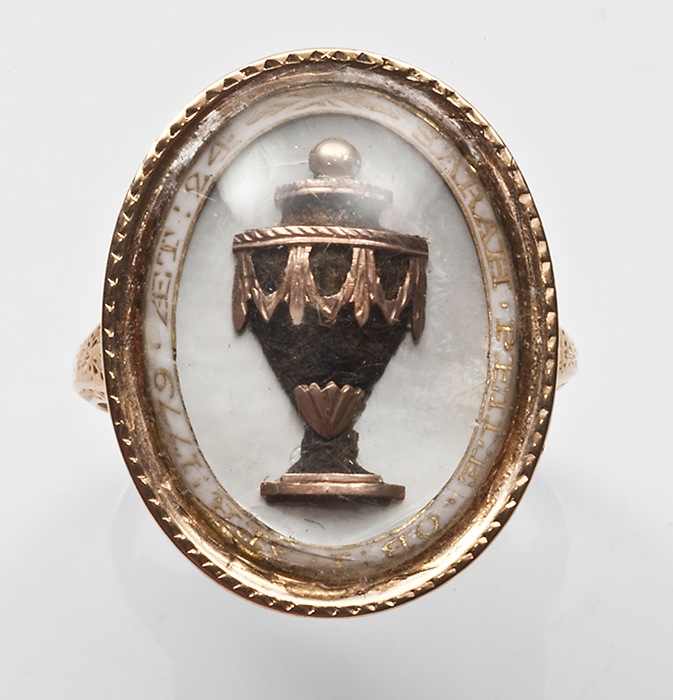
This garland carries through to the top of the ring, draping down over the birds themselves and entered by a pearl. The pearl was highly fashionable during the late 18th century, with access to Oriental pearls. The proliferation of Chinese and East Asian styles in decorative arts gave way to the ‘Chinoiserie’ style, making design and construction, through to any materials gained from the East popular. In jewellery, goldsmiths were often at the mercy of their materials and what they could produce. For the period following the Terror, when French aristocratic jewels were taken and sold into Europe, the prices of gems dropped, allowing them to be used in jewels more abundantly. As a counter to this, the Napoleonic wars drained the amount of gold that was able to be used in jewels, forcing goldsmiths to make more from less, focusing on gold wire designs that looked larger than the amount of gold really was.
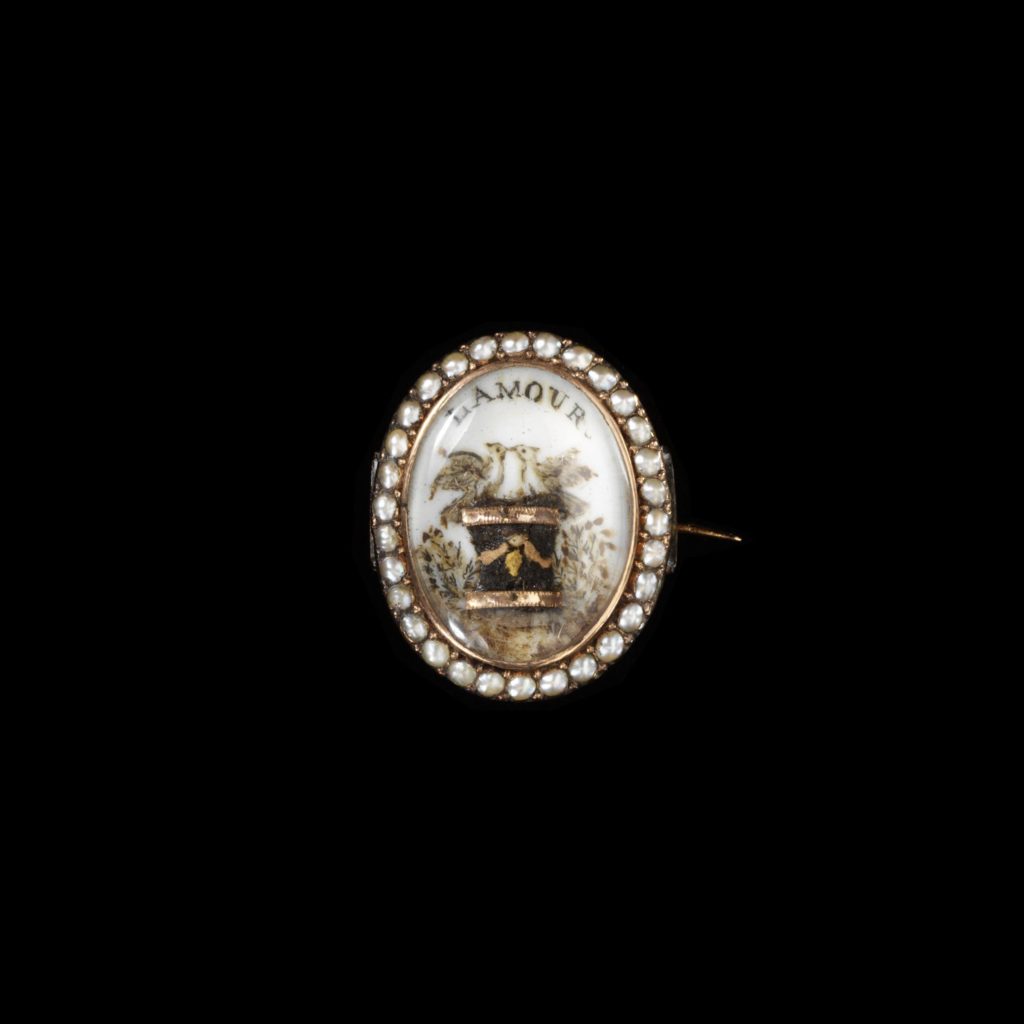
Sharing a moment is the heart of what this ring actually is trying to achieve. Its dedication is largely gone, due to a resizing under the band (replacing it is an American 14k hallmark), but the nature of the ring and its meaning is not necessarily post-mortem, but quite possibly an addition for a loved one who had departed. Appropriating a jewel, or any object, for the sake of retaining a memory is critical to what sentimentality is. Defining Neoclassical sentimentality is quite simple, due to the overt nature of what a brief look at a jewel needed to convey. The complexity and reference of an allegorical scenario is far too difficult for any one person to immediate recognise. What if a jewel’s design was so complex that it didn’t automatically convey death? How would that present itself in society? However, a jewel that had been worn for the nature of love, and if that loved one had departed, then it became the reference point for that person, the meaning remains the same. It’s still a token of love, which does not die when a person does, but grows stronger as the person tried to retain that memory.
Mourning jewels can be divided into social proprieties and objects of memory. This falls into the latter, as it could be worn fashionably for the sake of love.

Development of green enamel in jewels after the Neoclassical period retain the basic style seen in the ring. On the reverse of miniatures and on the trim or border of brooches or clasps, green enamel or green foil, was seen as a popular way of denoting status of love and sentimentality through colour. Being further removed from the jewels seen earlier, green was now becoming a colour that could be identified with rebirth, growth, renewal and rest. The Romantic period had influenced jewellery through art by stating that colour theory was important and not a periphery to the symbolism seen in art and jewellery. In the ring with the doves, the green enamel flanks the border of the ring in a triangular pattern. It interior sentiment with the doves, garlands and pearls is clear, as all jewels were of the Neoclassical period; clearly showing death or love in its statement. In this jewel that shows the next stage of sentimental jewellery design, it was the use of colour, pearls and the simplicity of the woven hair in a dedicated area.

The 1860s and the latter 19th century didn’t change the conceit of green as a symbol, but only used it sparingly where it resonated with the wearer/person whom commissioned it.
What is interesting about all of these jewels is that as they progress, there is still the balance of white enamel with the green enamel. If used for the purpose of death, white (purity/innocence) and green (rebirth) is almost a call for the unmarried, virginal youth to grow once more. Be it literal or for the sake of sentimentality, green enamel began to take its form as a colour which was acceptable during the third stage of mourning.
This resonated through to the 20th century with the Romantic Revival of the c.1900 period, where jewels used colours frequently and utilised green as a colour in enamel and foil to replicate the styles of the early 19th century. Miniatures and oval styles found their place in mainstream jewellery designs during the pre-WWI era of the 20th century, where some jewels are so perfectly replicated that they can only be judged by their weight.

For such a colourful ring, this jewel is both beautiful and sad. Beautiful in that it captures a moment between lovers and holds a reference for two in love, yet sad in that it was appropriated at one stage for death. As with all pristine things, the fading and disappearing over time, such as the inscription on this ring to its band, is inevitable. The fleeting moments we have and that which we spend are as precious as this singular jewel, which is what it will be to whomever holds it and passes it on to another loved one.





